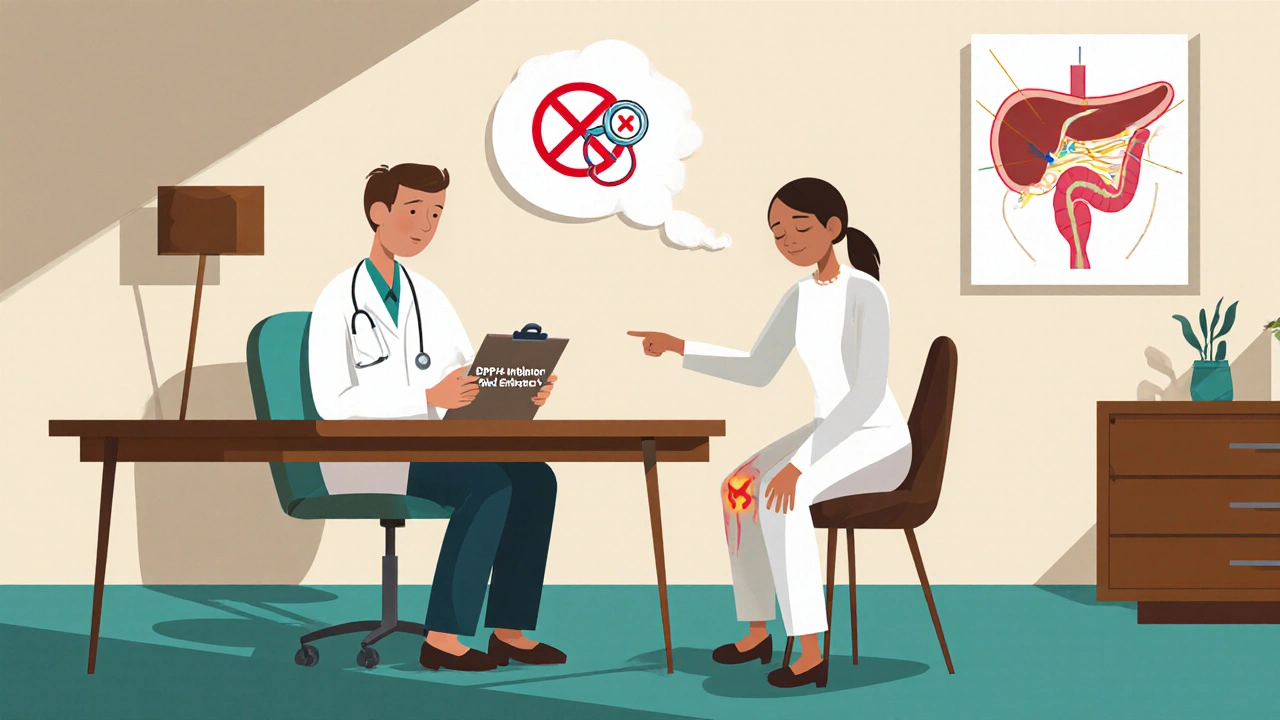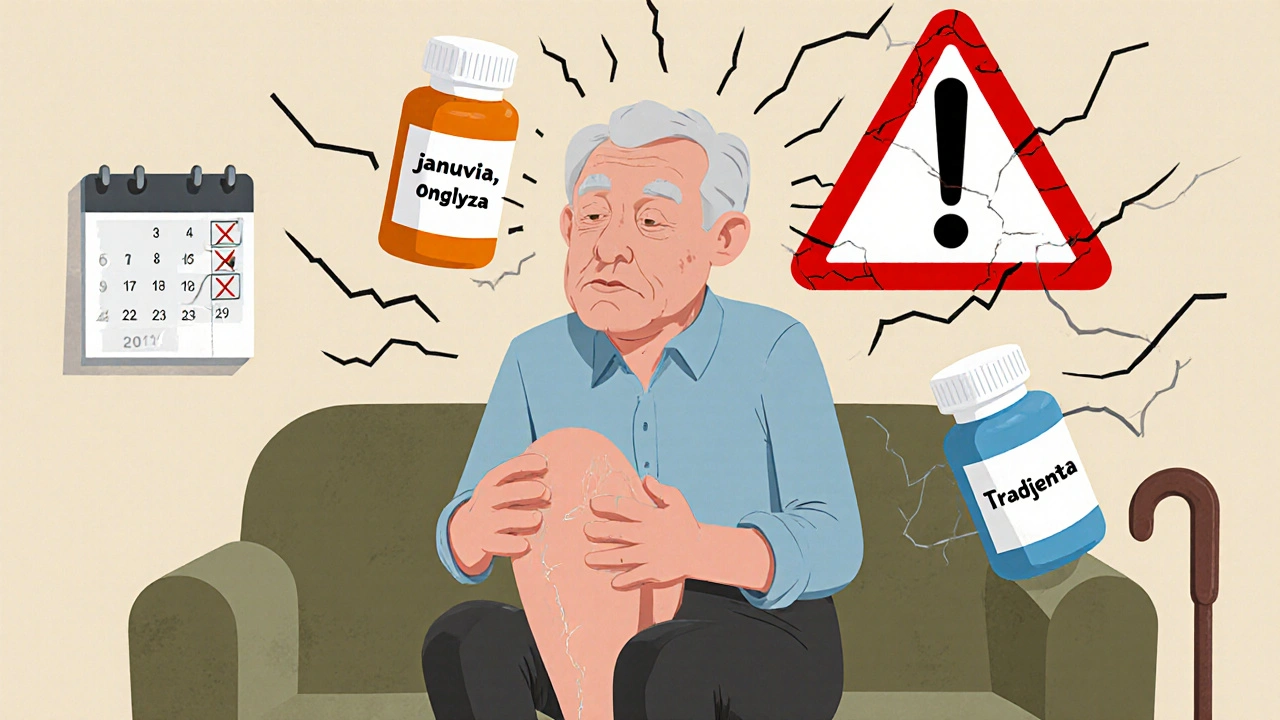DPP-4 Joint Pain Risk Checker
This tool helps you assess if your joint pain might be related to DPP-4 inhibitor medications. It is not medical advice. Always consult your doctor for diagnosis and treatment.
Your Risk Assessment
When you’re managing type 2 diabetes, finding a medication that keeps your blood sugar steady without wrecking your daily life is the goal. DPP-4 inhibitors like sitagliptin (Januvia), saxagliptin (Onglyza), and linagliptin (Tradjenta) have been go-to options for millions. They’re easy to take, don’t usually cause weight gain, and work well with other diabetes drugs. But for some people, a hidden side effect shows up - severe, unexplained joint pain that doesn’t go away. And it’s not just a mild ache. This pain can make walking, working, or even getting out of bed impossible.
What Are DPP-4 Inhibitors?
DPP-4 inhibitors are oral diabetes drugs that help your body use insulin more effectively. They work by blocking an enzyme called dipeptidyl peptidase-4, which breaks down incretin hormones. Those hormones tell your pancreas to release insulin after meals and stop your liver from pumping out too much glucose. The result? Better blood sugar control without the risk of low blood sugar crashes - unless you’re also taking sulfonylureas.
The first one, sitagliptin, got FDA approval in 2006. Since then, four others joined the list: saxagliptin, linagliptin, alogliptin, and vildagliptin (not sold in the U.S.). By 2022, sitagliptin alone was prescribed over 35 million times in the U.S. That’s a lot of people relying on these drugs. But behind the numbers, there’s a quieter story - one about joint pain that didn’t get enough attention until it was too late for some.
The FDA Warning That Changed Everything
In August 2015, the U.S. Food and Drug Administration dropped a bombshell. After reviewing over 7 years of adverse event reports - from 2006 to the end of 2013 - they found 33 cases of severe, disabling joint pain linked to DPP-4 inhibitors. Not just a few aches. These were cases where people couldn’t move, had to be hospitalized, or lost their jobs because their knees, hips, or hands hurt too much to function.
Here’s what stood out:
- 28 cases involved sitagliptin
- 5 involved saxagliptin
- 2 each for linagliptin and vildagliptin
- 1 for alogliptin
Even more telling: 5 patients had severe joint pain after taking two different DPP-4 inhibitors. That pointed to a class-wide issue, not just one bad drug. And when they stopped taking the medication, 23 out of 33 patients saw their pain vanish within a month. Eight of them got the pain back within days when they took the drug again. That’s the gold standard for proving a drug side effect - rechallenge and resolution.
The FDA didn’t pull these drugs off the market. Instead, they updated the labels. Now, every prescription bottle and doctor’s note includes a warning: “Severe and disabling joint pain has been reported with DPP-4 inhibitors.”
How Does the Pain Feel?
It’s not the kind of pain you get from overdoing it at the gym. This pain is deep, constant, and often symmetrical - meaning both knees, both wrists, or both shoulders hurt at the same time. Patients describe it as:
- A dull, throbbing ache that doesn’t improve with rest
- Worse in the morning or after sitting for long periods
- Not relieved by over-the-counter painkillers like ibuprofen
- Often accompanied by stiffness or swelling, even if tests show no arthritis
One woman in the FDA report started sittingagliptin and, three weeks later, couldn’t walk without help. Her knees were so painful she needed a cane. She thought it was early arthritis. Her rheumatologist ran every test - blood work, X-rays, even a rheumatoid factor test. Everything came back normal. Only after she stopped the drug did the pain fade. When she accidentally took a leftover pill, the pain returned within 48 hours. That’s the kind of pattern doctors now look for.

Is This Common?
Here’s the reality: severe joint pain from DPP-4 inhibitors is rare. The FDA found 33 cases out of millions of prescriptions. That’s less than 0.001%. But rarity doesn’t mean it’s not real. And for the people it affects, it’s devastating.
Some studies say the risk is small. A 2017 meta-analysis of 67 trials found a slight increase in joint discomfort overall - but not in severe cases. Another study in Taiwan, using insurance data, found no link at all. But those studies had limits. They relied on billing codes, not patient reports. They didn’t track whether pain got better after stopping the drug. That’s the key.
A 2021 study using real-world U.S. health records from the FDA’s Sentinel Initiative found a 24% higher risk of joint pain requiring medical care among DPP-4 users compared to other diabetes meds. That’s not a huge number, but it’s real. And in a population of 35 million prescriptions, even a small increase adds up.
What Should You Do If You Have Joint Pain?
Don’t panic. Don’t stop your medicine on your own. But do act.
If you’ve been on a DPP-4 inhibitor and start having new, persistent joint pain - especially if it’s severe or affects multiple joints - talk to your doctor right away. Tell them exactly when it started, how bad it is, and whether it’s getting worse. Mention the drug by name. Say: “I’m on sitagliptin, and I’ve had this joint pain for three weeks. It’s not going away.”
Your doctor should consider this side effect, even if you’ve been on the drug for a year. The FDA says pain can start anytime - within weeks or after months. One patient developed pain after 11 months of use. That’s not unusual.
If your doctor agrees it might be the drug, they’ll likely ask you to stop taking it for 4 to 6 weeks. Most people feel better in that time. If the pain returns when you restart the drug? That’s confirmation. Your doctor will switch you to another diabetes medication - maybe a GLP-1 agonist, SGLT2 inhibitor, or metformin.
What Else Should You Watch For?
DPP-4 inhibitors aren’t risk-free. Besides joint pain, they’ve been linked to:
- Pancreatitis - inflammation of the pancreas, which can be life-threatening
- Severe allergic reactions - swelling of the face, throat, or tongue
- Bullous pemphigoid - a rare skin condition that causes large, painful blisters
- Mild side effects like nausea, headaches, or a stuffy nose
Call your doctor immediately if you notice blisters, swelling, or sudden, severe abdominal pain. These are emergencies.

Why Do DPP-4 Inhibitors Cause Joint Pain?
No one knows for sure. The mechanism isn’t fully understood. But researchers have a few theories:
- DPP-4 isn’t just in the gut - it’s in joints, skin, and immune cells. Blocking it might trigger inflammation.
- It could be an autoimmune response - your body starts attacking joint tissue by mistake.
- Some patients may have a genetic sensitivity to how the drug affects certain immune signals.
What we do know is that the pain is real, it’s reversible, and it’s underdiagnosed. Many patients are told they have arthritis, fibromyalgia, or even depression. Only when the drug is stopped does the true cause come to light.
What Are the Alternatives?
If you need to stop a DPP-4 inhibitor, there are other effective options:
- Metformin - still the first-line drug for type 2 diabetes. Safe, cheap, and well-studied.
- SGLT2 inhibitors - like empagliflozin or dapagliflozin. They help with weight loss and heart protection, but can cause yeast infections or dehydration.
- GLP-1 agonists - like semaglutide (Ozempic) or liraglutide (Victoza). These are injectables but very effective for blood sugar and weight.
- Insulin - if other drugs aren’t enough, insulin is safe and reliable.
Your doctor will pick based on your age, other health issues, weight, and budget. You don’t have to stay on a drug that’s making you miserable.
Bottom Line
DPP-4 inhibitors work. For most people, they’re a good choice. But if you’re experiencing new, unexplained joint pain - especially if it’s severe or keeps coming back - don’t ignore it. It might not be aging, it might not be arthritis. It might be your medication.
Speak up. Get tested. Give your doctor the full picture. And remember: stopping the drug doesn’t mean failing at diabetes care. It means taking control - of your health, your body, and your life.


Barry Sanders
November 13, 2025 AT 14:37kshitij pandey
November 15, 2025 AT 12:24Brittany C
November 17, 2025 AT 02:03Sean Evans
November 17, 2025 AT 02:25Anjan Patel
November 18, 2025 AT 04:21Scarlett Walker
November 19, 2025 AT 08:27Hrudananda Rath
November 21, 2025 AT 05:55Brian Bell
November 22, 2025 AT 00:47Nathan Hsu
November 23, 2025 AT 14:36Ashley Durance
November 25, 2025 AT 12:28Scott Saleska
November 26, 2025 AT 10:59Ryan Anderson
November 27, 2025 AT 11:39Eleanora Keene
November 27, 2025 AT 20:31Joe Goodrow
November 28, 2025 AT 13:47Barry Sanders
November 29, 2025 AT 13:17